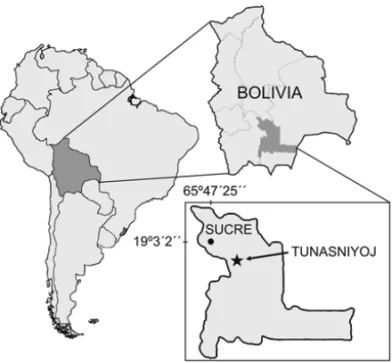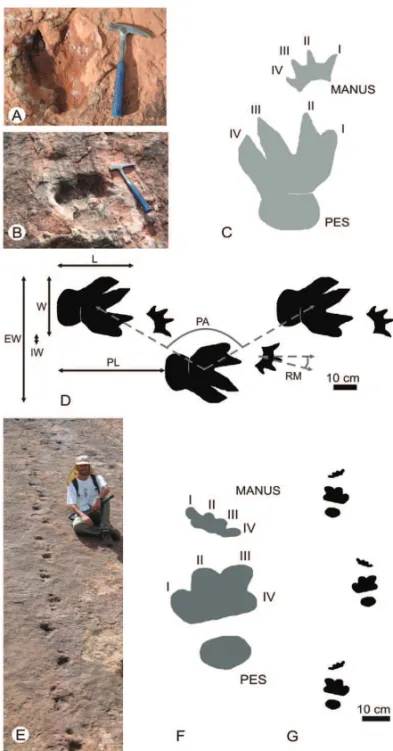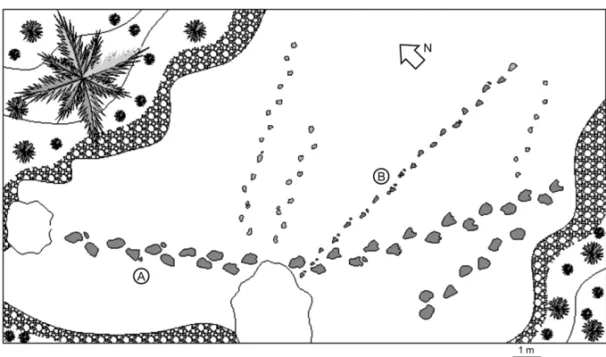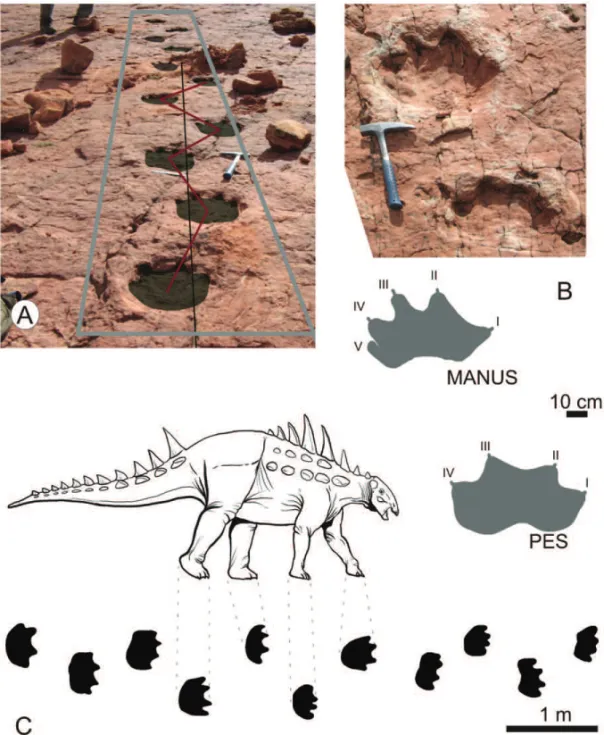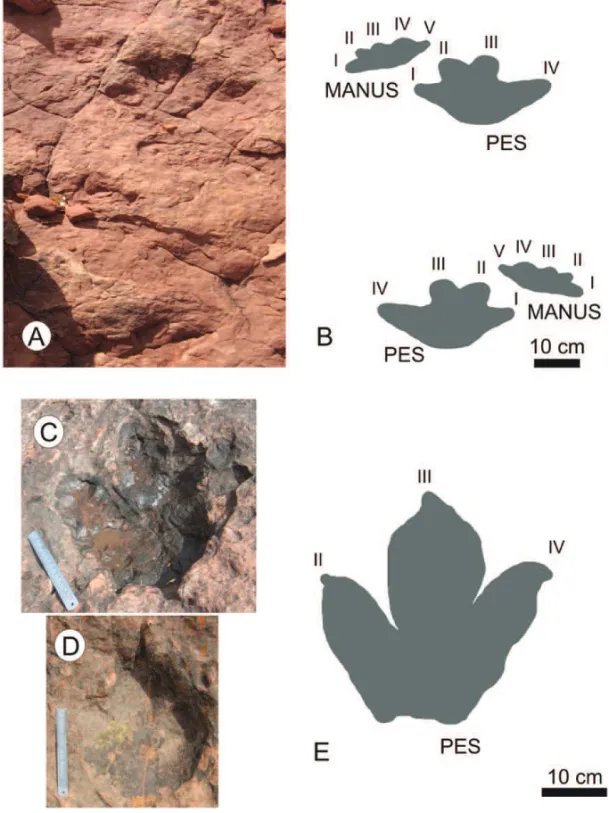(Annals of the Brazilian Academy of Sciences)
Printed version ISSN 0001-3765 / Online version ISSN 1678-2690 www.scielo.br/aabc
Tunasniyoj, a dinosaur tracksite from the Jurassic-Cretaceous
boundary of Bolivia
SEBASTIÁN APESTEGUÍA and PABLO A. GALLINA
CONICET – Fundación de Historia Natural “Félix de Azara”
CEBBAD – Universidad Maimónides, Hidalgo 775, 7◦piso, (1405) Ciudad Autónoma de Buenos Aires, Argentina
Manuscript received on October 9, 2009; accepted for publication on December 1, 2010
ABSTRACT
Here we report a superbly preserved and profusely represented five-ichnotaxa dinosaur track assemblage near Icla village, 100 km southeast of Sucre, Bolivia. As preserved in reddish Jurassic-Cretaceous boundary aeolian sandstones, this rich and uncommon assemblage is, additionally, the oldest dinosaur tracksite for Bolivia. Four trackmakers were identified in the area: three quadrupedal and one bipedal, all of them with tracks of around 35 cm in lenght. One of the quadrupedals is represented by no less than five adult individuals (ichnotaxon A), and four purported juveniles (ichnotaxon B) walking in association. The other two quadrupedals (ichnotaxa C and D) involve four trackways, and the last, the bipedal trackmaker (ichnotaxon E), is represented by one trackway. The five ichnotaxa represented in the “Palmar de Tunasniyoj” could be tentatively assigned to the following trackmakers: Ichnotaxa A and B are assigned to basal stegosaurians; ichnotaxon C to a basal tyreophoran, perhaps related to the ankylosaur lineage; ichnotaxon D to the Ankylosauria, and ichnotaxon E to Theropoda. The Tunasniyoj assemblage, the oldest dinosaur tracksite for Bolivia, includes the oldest known evidence assigned to ankylosaurs and stegosaurs for South America.
Key words:Bolivia, Chuquisaca, dinosaur prints, ichnology.
INTRODUCTION
South American dinosaurs became relatively well known along the last decades. However, most of the available knowledge comes from the osteological data preserved in Argentina and Brazil (Bonaparte 1996, Leanza et al. 2004). The ichnological record is still patchy and chrono-logically redundant, even when it comes from several localities in several countries (e.g., McCrea et al. 2001, Thulborn 1990). Actually, some of the better samples come from latest Cretaceous rocks of Bolivia (Lock-ley et al. 2002, Leonardi 1994) and Early Cretaceous of Brazil (Leonardi 1994). On the other side, although tracks in the Chacarilla Formation and Baños del Flaco, Chile (e.g., Moreno and Pino 2002, Rubilar-Rogers et al.
Proceedings of the Third Gondwanan Dinosaur Symposium Correspondence to: Sebastián Apesteguía
E-mail: sebapesteguia@gmail.com
2008), show a good abundance and preservation qual-ity of Early Cretaceous dinosaur tracks, they are mainly represented by sauropods, theropods and some large or-nithopods (Rubilar-Rogers et al. 2000, 2008). Here we report, in the oldest dinosaur tracksite for Bolivia, the ancientmost southern evidence of tyreophorans that, surprisingly, are represented by three different taxa, in-cluding ankylosaurs and the only stegosaur tracks for the Southern Hemisphere.
LOCALITY
Fig. 1 – Map location of the dinosaur track locality Tunasniyoj, Chu-quisaca Department, Bolivia.
TRACKSITE RECORD INBOLIVIA
The tracksites in Bolivia are actually abundant, but very poorly known, even for the best represented sites, such as Cal Orck’o, Humaca and Toro Toro (Lockley et al. 2002, Apesteguía et al. 2007, Ríos Cordero 2005). Be-sides, dinosaur tracks were already found in four of the nine Departments of Bolivia, in the localities of Ca-margo; Toro Toro and Arampampa, in Potosí (Branisa 1968); Sucre, Ñujchu and Maragua in Chuquisaca; and Santivañez and Parotani in Cochabamba, the latter dis-covered by Leonardi (1981) and lost after a landslide. However, whereas some of these areas preserve rocks that represent coastal to lacustrine deposits related to the Atlantic transgression of the Pacha Sea (e.g., Sucre and El Molino formations), some others show exposi-tions of slightly older rocks (e.g., Toro Toro and Chau-naca formations). This means that most of these track-sites basically preserves the same ichnofauna, probably indicating the existence of a same fauna that lived along the coasts of the seaway that flooded the southern half of the Potosí basin (Fiedler et al. 2003) by the end of the Cretaceous.
Conversely, the new locality of Tunasniyoj repres-ents levels that are considered around 73 million years older than all the previously mentioned Upper Creta-ceous localities, opening the chance to study a dino-saurian ichnofauna ignored up to now in the region.
GEOLOGICAL SETTING
The Tunasniyoj tracksite is located in the Chuquisaca side of the Incapampa-Icla syncline. This forms part of a syncline system that exposes a Tertiary core sur-rounded by Cretaceous to Jurassic verticalized beds that outcrop in several Departments of Bolivia in the eastern part of the Andes. The bearing beds, thus, form well-developed walls of reddish sandstones, locally covered by basalt flows originated during the Early Cretaceous (Almeida et al. 1996). The track-bearing beds are part of the fluvial to aeolian La Puerta Formation, deposited in Late Jurassic to Early Cretaceous time (Almeida et al. 1996). As different units considered to have been deposited during the latest Jurassic to earliest Creta-ceous from Brasil, Bolivia, Paraguay, Uruguay and Ar-gentina show an aeolian signature, it is possible that the La Puerta Formation could be a distal extension of the Brazilian unit, known as the Botucatú desert (Scherer 2000).
MATERIALS AND METHODS
Tracks were exposed by clearing away sand, small rocks and debris. Measurements were taken directly from trackway impressions, following standard ichnological conventions (see Table I).
TABLE I
Measurements of the Tunasniyoj tracks. (?) unknown. (–) not applicable.
Length Width Pace length Internal trackway External trackway Pace angulation Rotation from (cm) (cm) (cm) width (cm) width (cm) (◦) midline (◦)
Adult
11 14 50 3 33 120 5-15
manus Adult
35 25 50 3 60 120 0
Ichnotaxon pes A Juvenile
3 5-6 40 5 18 145 24
manus Juvenile
12 9 40 1 20 145 –14
pes
Ichnotaxon Manus 21 30 ? ? ? ? 13
B Pes 25 35 122 48 103 100 0
Ichnotaxon Manus 15 23.5 52.5 16.5 60 ? 16
C Pes 18 35 52.5 –25 45 ? 0
Ichnotaxon Manus – – – – – – –
D Pes 35 35 ? ? ? ? ?
RESULTS
Five ichnotaxa, named as A, B, C, D, and E, were de-scribed in the area. They were later assigned to four dif-ferent trackmakers, three of them quadrupedal and one bipedal.
Ichnotaxon A(Fig. 2A-D). It is the most abundant ich-notaxon and is represented by several trackways. They are not undertracks. They correspond to quadrupedal animals, presumably adults. The four digit pes impres-sions show a paraxonic arrangement and a probable syn-dactily between the imprints of digit I and II. The heel mark is separated from the rest of the footprint show-ing a transversal positive epichnial ridge in some im-pressions (Fig. 2B). The pes impression length is about 35 cm, and its width is 25 cm. A great number of prints was preserved as long and continuous trackways that reach 30 m in length (Fig. 3A), with an average pace an-gulation of 120◦for the footprints. Both pes and manus
paces length is 50 cm. Further, the average outer track-way width is 60 cm, and the inner tracktrack-way width ranges from 0 cm to 5 cm, thus corresponding to a narrow track-way. Manus imprints are tetradactyl, short and broad, with about 11 cm in length and 14 cm in width. The manus impressions are located anterior and medially to the pes impressions, and show a slight rotation relative to the midline, which ranges from 5◦to 15◦. The angles
formed by the digit imprints are homogeneous, having an average of 30◦, depicting an arch of 120◦.
Ichnotaxon B(Fig. 2E-G). These tracks were made by a quadrupedal animal and they are three times smaller than those of ichnotaxon A. The tetradactyl pes impres-sion is symmetrical, with the imprints of the digits I, II and III directed forwards, and the IV laterally projected. The heel mark is well separated from the anterior part of the footprint by 3 cm. Pes impression length is about 12 cm, and the average width is 9 cm. The longest track-ways comprise 20 continuous steps (Fig. 3B), with an average pace angulation of 145◦for the footprints. The
pes and manus imprints display an average pace length of 40 cm, while an external/internal width ranges from 20 cm to 5 cm, respectively.
The manus print has four digit impressions. It is short and broad, with a manus length of about 3 cm and range width from 5 cm to 6 cm. Digit imprints are sym-metrically arranged in a wide arch of 140◦to 160◦. As
in ichnotaxon A, manus prints are located in front of footprints displaying an outward rotation from midline.
repre-Fig. 2 – Ichnotaxa A and B. Pes and manus of the Icnotaxon A (A, B, C), trackway scheme with distances preserved and principal measurements taken (D). Ichnotaxon B trackways (E), track and trackway scheme (F, G). Abbreviations: EW, external trackway width; IW, internal trackway width; L, length; PA, pace angulation; PL, pace length; RM, rotation from midline; W, width.
sented by four trackways about 15 m in length and with an average pace angulation of 100◦. Pes impressions
have a pace length of about 122 cm. There is an evident change in width along the trackway as a consequence of a small change of direction of travel at midway. The maximum external trackway width, here interpreted as
the normal pace width, is 103 cm, and the internal width is 48 cm. On the other hand, by the zone of change di-rection, the maximum width decreased to 71 cm, and the internal width became 20 cm (negative value), overlap-ping the midline of the trackway.
Manus prints are only present in few specimens, but all of them are well preserved. Manus print is pen-tadactyl, short and kidney-shaped, with a deep poste-rior excavation. It is transversally long and the finger impressions depict a splayed arch. All digits imprints but V have evident claw marks. Digits imprints are sym-metrically displayed, but some specimens show digit I opposed to the rest. The impressions of the digits IV and V are in syndactily.
Ichnotaxon D(Fig. 5A-B). This ichnotaxon, less fre-quent than ichnotaxa A, B, and C, is represented by some few trackways, with manus and pes impressions from a large quadrupedal animal.
The four-digited pes imprint is asymmetric with digit IV directed laterally, which is separated from the others. Digit I imprint, even smaller, is opposed (antero-medially directed) to digit IV imprint. Digits II and III imprints are projected forwards and partially fused at the base.
Footprint is wide and short, and no heel mark is present (Fig. 5A, B). The length of the pes is 18 cm and 35 cm in maximum width between digits I and IV. This taxon is represented only by a single partial trackway that includes two pes and manus couples. The pace of the pes tracks is about 52.5 cm in length. Manus print is pentadactyl, very short, and with very small digits im-pressions depicting a serrated anterior border. It shows an inwards rotation of 37◦ from the midline. There is
no evidence of claw marks. The first three digit impres-sions are medially oriented, with digit IV projected for-wards and digit V directed anterolaterally.
Fig. 3 – Trackway map of ichnotaxa A and B showing spatial relation between both ichnotaxa trackways.
DISCUSSION
IDENTIFICATION OF THETUNASNIYOJTRACKMAKERS
The establishment of unequivocal relationships between a fossil track and its possible producer is highly specula-tive, and assignations are, as much, tentative. However, the knowledge gathered after the study of the skeletal anatomy of several dinosaur groups allows a correlation between skeletal structure and track shape.
In this case of study, most of the tracks were pro-duced by taxa that are poorly known or very debated in bibliography. Among them, stegosaurians are one of the most problematic. Most of the discussion on stegosaurian footprint assignment is based on time cor-relation and its osteological presence in the bearing lo-cality. However, in South America, the only stegosaur remains are restricted to basal forms found in Barre-mian rocks of Patagonia (Bonaparte 1996). This opens the panorama to find stegosaurian tracks in any South American Early Cretaceous tracksite and perhaps in all Gondwanan, after the re-assignment of the material from the Early Jurassic of Australia originally described by Hill et al. (1966). The finding of the Late Jurassic stegosaur Kentrosaurus Hennig (1915) in Tendaguru, Tanzania, is in agreement with this hypothesis. After the poor South American stegosaurian remains, it is de-duced that there existed a radiation of basal forms and, thus, is expected to find tetradactyl forms.
Five ichnotaxa are represented in the “Palmar de Tunasniyoj”. Four of them were likely produced by non-ornithischian ornithopods, and one by a probable saurischian.
Ichnotaxa A and B. The material from Bolivia in-cludes a separation of the pes impressions in two sym-metrical units: the digit imprints and the anterior part of the sole and the heel mark (Fig. 2B, E). Further, the impressions of the digits splayed in two divaricating axes, partially resembling the situation present in artio-dactyls like cows and camels.
Besides the discussion of bipedal or quadrupedal gait in stegosaurs, which is irrelevant in animals that were anatomically capable to use both stances, one of the main concerns to consider the identity of ichnotaxa A and B is that their pedal tracks are not tridactyle, as diagnosed forStegopodus and presumed for most pur-ported stegosaur tracks (e.g., Gierlinski and Sabath 2008). Ichnotaxa A and B also differ fromStegopodus in the blunt and short toed pedal prints of the latter.
ConsideringDeltapodustracks, which are also con-sidered as tridactyles, some specimens show an inner bulging (Whyte and Romano 2001, Fig. 4) of the sec-ond toe that could actually correspsec-ond to the reduced digit I of ichnotaxon A. This is especially visible in
D. brodricki(Whyte and Romano 2001, Fig. 4), which
(Moss-Fig. 4 – Ichnotaxon C. Trackway (A), isolated pes and manus of adult specimens in photograph (B up) and scheme (B down), detailed trackway scheme with distances preserved (C).
brucker et al. 2008), with an extremely wide inner digit, and the clearly tetradactyle footprints from the Early Jurassic of Morocco (Jenny and Jossen 1982, Type C) were already suggested to be related to stegosaur ac-tivity. Furthermore, the Australian tracks reported by Long (1998) show this more clearly, not having only an additional toe but also showing it in a position that seems to support sindactily between toes I and II (Scan-lon 2006, Fig. 5D). Additionally, they share with the Tunasniyoj material a deep embayment between the II and III toes, though very asymmetrically distributed.
Fig. 5 – Ichnotaxon D. Trackway (A) and scheme with distances preserved (B). Ichnotaxon E. Track (C, D) and detailed scheme (E).
trackways (Lockley and Hunt 1998), the available mate-rial shows that, by the Early Cretaceous, only basal forms were present in South America (Bonaparte 1996). Basal stegosaurians are considered to have four pedal digits with a reduced digit I, as also regarded for the long-toed
form Tetrapodosaurus(Sternberg 1932) considered as
produced by a basal ankylosaurian or even a ceratopsian (Gierlinski and Sabath 2008; but see McCrea et al. 2001, who compares it with theSauropeltaskeleton).
in-creasing the pedal diversity of the group.
The strong heel of ichnotaxa A and B, a feature fre-quently cited as present in stegosaurian tracks, turns the track much longer than wide. This strong heel is also present in the short-toed ichnogenusNavahopus(Baird 1980) orApulosauripus(Nicosia et al. 1999), considered as produced by possible ankylosaurians, andDeltapodus (Whyte and Romano 1994) from the Saltwick Forma-tion, considered as stegosaurian in origin (Whyte and Romano 2001, Fig. 3), and supported by additional ste-gosaurian skeletal remains from the Late Jurassic of Asturias (Spain) (Lires et al 2002, García-Ramos et al. 2004). Gierlinsky and Sabath (2008) have considered thatDeltapodusbears a sauropod-like aspect. However, we agree more with the stegosaurian interpretation of Whyte and Romano (2001).
The manus imprints of Deltapodusare also simi-lar to those coming from the Tunasniyoj locality, with a manus short, wide and describing an arch. However, sev-eral differences preclude assigning the Bolivian material to that genus (e.g., well-defined digits, outward rotation, and digit one in the same line of others in the Tunasniyoj material).
The manus of ichnotaxa A and B differs from the Australian material described by Long (1998) mainly in the higher heteropody and in the presence of four instead of five digits in the former.
In sum, we suggest that ichnotaxa A and B were produced by a basal stegosaur trackmaker, based both in an anatomical correlation plus the temporal frame-work. These tyreophoran dinosaurs, highly specialized heteropodal quadrupeds, show a short trunk relative to the length of their hindlimbs. Additionally, their short forelimbs produce a peculiar movement when walking; this is translated in the tracks as an orientation of the manus outwards. The manus imprint in ichnotaxon A is entaxonic and tetradactyl.
Ichnotaxon C. The comparison of this ichnotaxon also suggests a tyreophoran trackmaker. Four digited feet are well developed in basal tyreophoran forms compa-rable toScelidosaurus(Norman 2001) andPolacanthus (Blows 1987) (Fig. 4C). Ichnotaxon C is very similar to the tetradactyl and roundedTetrapodosaurus borea-lis, from British Columbia, Canada (Sternberg 1932). Although Tetrapodosaurushas manus print well
docu-mented, this is not the case of ichnotaxon C, in which footprints overlap manus prints in most trackways. In this way, a similar condition seems to be present in track-ways attributed to ankylosaurs from the Late Cretaceous of Brazil (Huene 1931, Thulborn 1990). Tetrapodo-saurustrackmakers were assigned as ankylosaurs or re-lated (Thulborn 1990, Whyte and Romano 2001), or cer-atopsians (Gierlinski and Sabath 2008). In the case of ichnotaxon C, the anatomical correlation and temporal framework are consistent with a trackmaker assignment as a basal tyreophoran, perhaps related to the ankylosaur lineage. As this group spread very early along the Meso-zoic world, it is expected that unspecialized basal tyreo-phorans lived in South America.
Ichnotaxon D. Besides represented by only few tracks, its distinct morphology allows its assignment to the An-kylosauria, which is already known from the younger strata of Cal Orck’o, Sucre (McCrea et al. 2001), in the El Molino Formation and in Toro Toro, Potosí, in the Toro Toro Formation or in the lower member of the El Molino (Gayet et al. 1991). The latter includes the holotype ofLigabueichnium bolivianumLeonardi 1984, considered both as a Ceratopsia or an Ankylosauria. Unfortunately, they are badly preserved for compar-isons. Considering the age of the bearing rocks, these tracks actually represent the older evidence of these di-nosaurs for the Southern Hemisphere, even older than the Early CretaceousMinmifrom Australia (Molnar 1980).
Ichnotaxon E. The only tracks assigned here to thero-pod dinosaurs, so abundant in other assemblages (e.g., Lockley et al. 2002, Leonardi 1994, Rubilar-Rogers et al. 2008), are those represented by ichnotaxon E. However, they are quite unusual for the group. The tracks are extremely wide, and digits are petal-shaped, resem-bling ornithopod tracks. Therefore, the main reason for its assignment to Theropoda is mainly based on the terminal sharp claw marks.
LimayichnusCalvo 1991, although assigned to huge or-nithopods. Considering the evidence studied here, Li-mayichnuscould also be related to large tetanurans like carcharodontosaurids, which are already known for the site (i.e., Giganotosaurus carolinii Coria and Salgado 1995). The presence of these theropods in Tunasniyoj is in agreement with the Early Cretaceous age of the site (Apesteguía 2002, Leanza et al. 2004), and different from the latest Cretaceous tracks of the El Molino For-mation.
CONCLUSIONS
The discovery of a new well-preserved tracksite in hori-zons 73 million years older than all those previously known in Bolivia opens the possibility to acknowledge the different forms that lived towards the Jurassic-Cretaceous boundary and to explore how ichnofaunas evolved. As many researches demonstrated during the last years, several tetrapod lineages actually originated much earlier than expected, and long ghost lineages were proposed to explain their presences in Late Creta-ceous outcrops, an aspect that highlights the importance of Late Jurassic-Early Cretaceous presences.
The presence of confirmed thyreophorans in South-ern continents was proposed after the description of the Australian Early Cretaceous Broome Sandstone tracks (Hill et al. 1966) and later by osteological findings in South America (e.g., Bonaparte 1996, Coria and Sal-gado 2001), Africa (e.g., Hennig 1915) Antarctica (e.g., Gasparini et al. 1996), and New Zealand (e.g., Wiffen 1996).
The group is distinguishable in the tracksite record by their four to five short, hoof-like toes, different from the laterally reduced pattern seen in saurischians and ornithopods. Australian tracks show broad five-toed hands and narrower hind feet with three functional toes but up to four digits.
Other candidates for a similar kind of tracks, the neoceratopsians, are not considered as possible Gond-wanan pre-Campanian inhabitors. Thus, the possible producers are reduced to scelidosaurs, early stegosaurs, or basal ankylosaurians. Despite stegosaurs were com-mon in the Late Jurassic of Laurasia, basal forms have been reported for the Early Cretaceous of several places in the world. In the Southern hemisphere, stegosaur
tracks have only been described from Australia (Long 1998). Their crescentic shape, five-fingered manus tracks and broad and notably heeled pes tracks are char-acteristic of this group.
Considering that the Australian tracks and those of Tunasniyoj share manus tracks with several (four to five) short and well-defined digits, no inward directed pollex claw, and pes tracks broad and square in outline, with a deep divarication in the case of the Bolivian ma-terial, they were probably produced by stegosaurs be-longing to the same lineage, differing from the tridactyle forms from the Jurassic of North America, as those of Deltapodus.
Most of the track localities of South America are represented in rocks from the uppermost Cretaceous, and older track assemblages display a poor to moder-ate preservation, providing this discovery with both tem-poral and regional significance. The Tunasniyoj assem-blage is the oldest dinosaur tracksite for Bolivia, and includes the oldest known evidence assigned to anky-losaurs and stegosaurs for South America.
ACKNOWLEDGMENTS
RESUMO
Neste estudo é relatado um conjunto magnificamente preser-vado de pistas de dinossauros representados por cinco táxons distintos, situado próximo à Vila de Icla, 100 quilômetros a sudeste do Sucre, Bolívia. Preservados em arenitos eólicos avermelhados do limite Jurássico-Cretáceo. Quatro formas ge-radoras foram identificadas na área, sendo três quadrúpedes e um bípede, todos com as pegadas com cerca de 35 cm de comprimento. Um dos quadrúpedes (trilhas tipos A e B) é re-presentado por pelo menos seis indivíduos em dois grupos de três, com adultos e juvenis juntos. Os outros dois quadrúpedes (trilhas tipos C e D) são geradores de quatro trilhas, e um gera-dor bípede (trilha E), é representado por uma trilha. Os quatro icnotáxons representados em “Palmar de Tunasniyoj”, podem provisoriamente ser atribuídos aos seguintes geradores: Icno-táxon A e B são atribuídos a estegossauros basais. IcnoIcno-táxon C a um tireóforo basal, talvez relacionado à linhagem dos an-quilossauros. Icnotáxon D aos Ankylosauria; e icnotáxon E a Theropoda. Este raro e belo conjunto de trilhas de dinossauros de Tunasniyoj, representa ainda a icnocenose mais antiga de dinossauros da Bolívia. Além disso, inclui a mais antiga evi-dência conhecida atribuída a anquilossauros e estegossauros para América do sul.
Palavras-chave: Bolívia, Chuquisaca, pegadas de dinos-sauros, icnologia.
REFERENCES
ALMEIDALF, PÉREZMORALESR, CARRASCOCÓRDOVA RANDPALENQUE DE LAQUINTANAGA. 1996. Mapas temáticos de Recursos minerales de Bolivia, Hoja Sucre. Serv Geol Bol Serie II-MTB-8B.
APESTEGUÍAS. 2002. Successional structure in continental tetrapod faunas from Argentina along the Cretaceous. Bol 6thSimp Cret Brazil – 2ndSimp Cret Am Sur Abst, p. 135– 141.
APESTEGUÍA S, DE VALAIS S, MEYER CA, RÍOSCOR -DEROGANDRAMIREZOM. 2007. Reduced inner toe theropod trackways from El Molino Formation (Maas-trichthian) at Toro Toro (Bolivia). Abstracts V Reun Arg de Icnol and III Reun de Icnol del Mercosur 47.
BAIRD D. 1980. A prosauropod dinosaur trackway from the Navajo Sandstone (Lower Jurassic) of Arizona. In: JACOBS LL (Ed), Aspects of Vertebrate History. Flag-staff: Museum of Northern Arizona Press, p. 219–230. BLOWSWT. 1987. The armoured dinosaurPolacanthus foxi,
from the Lower Cretaceous of the Isle of Wight. Palaeon-tology 30: 557–580.
BONAPARTEJF. 1996. Cretaceous Tetrapods of Argentina. In: PFEIL F AND ARRATIA G (Eds), Contributions of southern South America to Vertebrate Paleontology. Münchner Geowissenschaftliche Abhandlungen. Reihe A Geol und Paläont, p. 73–130.
BRANISAL. 1968. Hallazgo del amonite Neolobitesen la Caliza Miraflores y de huellas de dinosaurios en la Forma-ción El Molino y su significado para la determinaForma-ción de la edad del “Grupo Puca”. Bol Inst Boliv Petr 8: 16–28. CALVOJO. 1991. Huellas de Dinosaurios en la Formación Río
Limay (Albiano-Cenomaniano), Picún Leufú, provincia del Neuquén, Argentina (Ornithischia-Saurischia-Sauro-poda-Theropoda). Ameghiniana 28: 241–258.
CORIARAANDSALGADOL. 1995. A new giant carnivorous dinosaur from the Cretaceous of Patagonia. Nature 377: 224–226.
CORIARAANDSALGADOL. 2001. South American anky-losars. In: CARPENTERK (Ed), The armored dinosaurs, Indiana University Press, p. 159–168.
FIEDLERK, MERTMANNNDANDJACOBSHAGENV. 2003. Cretaceous marine ingressions in the southern Potosi Basin of southern Bolivia: tectonic and eustatic control. Rev YPFB 21: 157–164.
GARCÍA-RAMOSJC, PIÑUELALANDLIRESJ. 2004. Guía del Jurásico de Asturias. Ed. Zinco Comunicación, Gi-jón, 118 p.
GASPARINIZ, PEREDA-SUBERBIOLAXANDMOLNARRE. 1996. New data on the ankylosaurian dinosaur from the late Cretaceous of the Antarctic Peninsula. Mem Queensl Mus 39: 583–594.
GAYETM, MARSHALLLGANDSEMPERE T. 1991. The Mesozoic and Paleocene vertebrates of Bolivia and their stratigraphic context: a review. In: SUÁREZ-SORUCO R (Ed), Fósiles y facies de Bolivia-Vol. 1 Vertebrados. Revista Técnica de YPFB 12(3-4): 393–433.
GIERLINSKIGDANDSABATHK. 2002. A probable stego-saurian track from the Late Jurassic of Poland. Acta Pal Pol 47(3): 561–564.
GIERLINSKIGDANDSABATHK. 2008. Stegosaurian foot-prints from the Morrison Formation of Utah and their implications for interpreting other ornithischian tracks. Oryctos 8: 29–46.
HENNIGE. 1915.Kentrosaurus aethiopicus, der Stegosauride des Tendaguru. Sitzungsber Ges Naturforsch, p. 219–247. HILLD, PLAYFORDGANDWOODSJT. 1966. Jurassic Fos-sils of Queensland. Queensland Paleontographical Soci-ety, Brisbane, 210 p.
JENNYJANDJOSSENJA. 1982. Découverte d’empreintes de pas de dinosauriens dans le Jurassique inférieur (Pliens-bachien) du Haut Atlas Central (Maroc) du Haut Atlas Central. Comp Rend des Sean de l’Acad des Scien de Paris, Ser II 294: 223–226.
LEANZA HA, APESTEGUÍA S, NOVAS FE AND DE LA FUENTEMS. 2004. Cretaceous terrestrial beds from the Neuquén basin (Argentina) and their tetrapod assem-blages. Cret Res 25(1): 1–96.
LEONARDIG. 1981. As localidades com rastros fósseis de tetrápodes na América Latina. Anais 2◦Congr Latin-am
Paleont 2: 929–940.
LEONARDIG. 1984. Le impronte fossili di dinosauri. In: Sulle ormi del dinosauri. Erizzo Publishers, p. 162–186. LEONARDIG. 1994. Annotated atlas of South America
tetra-pods footprints (Devonian to Holocene). Comp de Pesq de Rec Min, Brasil, p. 39–41.
LIRESJ, GARCIA-RAMOSJCANDPIÑUELA L. 2002. Ic-nitas de estegosaurios en los del Jurasico Superior de As-turias. In: PÉREZ-LORENTEF (Ed), Dinosaurios y Otros Reptiles Mesozoicos de España. Logroño: Resúmenes de las comunicaciones, ponencias y paneles, p. 30–31. LOCKLEYM, SCHULPAS, MEYERCA, LEONARDIGAND
MAMANI KD. 2002. Titanosaurid trackways from the Upper Cretaceous of Bolivia: evidence for large manus, wide-gauge locomotion and gregarious behaviour. Cret Res 23: 383–400.
LOCKLEYMGANDHUNTAP. 1998. A probable stegosaur tracks from the Morrison Formation of Utah. In: CAR -PENTER K, CHURE D AND KIRKLAND J (Eds), The Upper Jurassic Morrison Formation: an interdisciplinary study. Mod Geol 23: 331–342.
LONGJA. 1998. Dinosaurs of Australia and New Zealand and Other Animals of the Mesozoic Era, Harvard University Press, Cambridge, 188 p.
MCCREA RT, LOCKLEY MG AND MEYER CA. 2001. Global distribution of purported track occurrences. In: CARPENTERK (Ed), The armored dinosaurs. Blooming-ton and Indianapolis: Indiana University Press, p. 413– 454.
MOLNARRE. 1980. An ankylosaur (Ornithischia: Reptilia) from the Lower Cretaceous of southern Queensland. Mem Queens Mus 20: 65–75.
MORENOKANDPINOM. 2002. Huellas de dinosaurios en la Formación Baños del Flaco (Titoniano-Jurásico Supe-rior), VI Región, Chile: paleoetología y paleoambiente. Rev Geol Chile 29: 191–206.
MOSSBRUCKER M, LOCKLEY MG, GIERLINSKI G AND HUPSK. 2008. Probable stegosaur tracks from the
Juras-sic Morrison Formation, Colorado and Utah. Din Rid Ann Rep 20: 26–29.
NICOSIAU, MARINOM, MARIOTTIN, MURAROC, PANI -GUTTIS, PETTI FM ANDSACCHIE. 1999. The Late Cretaceous dinosaur tracksite near Altamura (Bari, south-ern Italy). Geol Rom 35: 237–247.
NORMAND. 2001. Scelidosaurus, the earliest complete di-nosaur. In: CARPENTERK (Ed), The armored dinosaurs. Bloomington and Indianapolis: Indiana University Press, p. 3–24.
RAUHUT OWM. 2004. Provenance and anatomy of Ge-nyodectes serus, a large-toothed ceratosaur (Dinosauria: Theropoda) from Patagonia. J Vert Paleont 24: 894–902. RÍOSCORDERO G. 2005. Contribución al Estudio de Di-nosaurios en Bolivia. Informe de la expedición Toro Toro. 2004. Identificación de icnitas de dinosaurios del Parque Nacional Toro Toro, Provincia Charcas, Potosí. Pub del Club Paleont Boliv “FosilBol”, 20 p.
RUBILAR-ROGERSD, MORENOKANDBLANCON. 2000. Grandes huellas de ornitópodos en la Formación Chaca-rilla: icnofacies indicadoras del Cretácico Inferior. IX Congreso Geológico Chileno. Servicio Nacional de Geo-logía y Minería, Puerto Varas, Chile, 4 p.
RUBILAR-ROGERSD, MORENOK, BLANCONANDCAL -VO JO. 2008. Theropod dinosaur trackways from the Lower Cretaceous of the Chacarilla Formation, Chile. Rev Geol de Chile 35: 175–184.
SCANLONJD. 2006. Dinosaurs and other Mesozoic reptiles of Australasia. In: MERRICKJR, ARCHERM, HICKEY G ANDLEE M (Eds), Evolution and Biogeography of Australasian Vertebrates. AuSciPub, Sydney, p. 265–290. SCHERERCMS. 2000. Eolian dunes of the Botucatu Forma-tion (Cretaceous) in southernmost Brazil. Sed Geol 137: 63–84.
STERNBERGCM. 1932. Dinosaur tracks from Peace River, British Columbia. Natl Museum Can Bull 68: 59–85. THULBORNT. 1990. Dinosaur tracks. Chapman and Hall,
London, 410 p.
WHYTEMA ANDROMANO M. 1994. Probable sauropod footprints from the Middle Jurassic of Yorkshire, England. Gaia 10: 15–26.
WHYTEMA ANDROMANO M. 2001. Probable stegosau-rian dinosaur tracks from the Saltwick Formation (Middle Jurassic) of Yorkshire, England. Proc Geol Assoc 112: 45–54.
